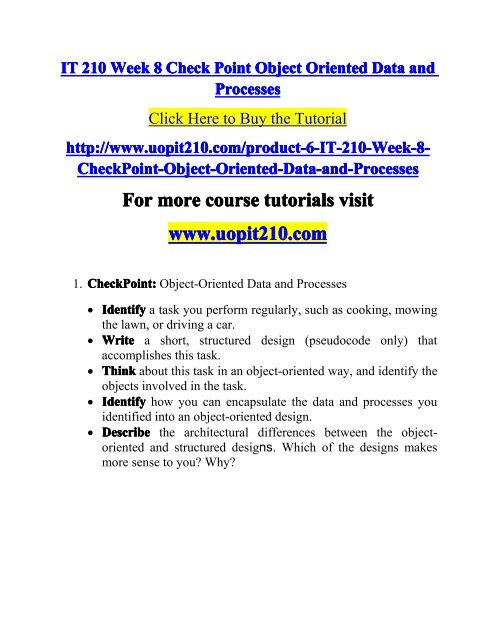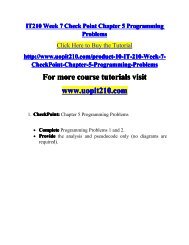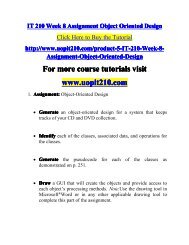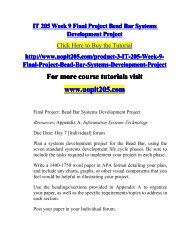IT 210 Week 8 CheckPoint Object Oriented Data and Processes
For more course tutorials visit www.uopit210.com 1. CheckPoint: Interfaces and Communication Messages Understanding object-oriented methodologies is often difficult. You already understand that object-oriented analysis and design emulates the way human beings tend to think and conceptualize problems in the everyday world. With a little practice, object-oriented programming will become second nature to you. As an example, consider a typical house in which there are several bedrooms, a kitchen, and a laundry room—each with a distinct function. You sleep in the bedroom, you wash clothes in the laundry room, and you cook in the kitchen. Each room encapsulates all the items needed to complete the necessary tasks. You do not have an oven in the laundry room or a washing machine in the kitchen. However, when you do the laundry, you do not just add clothes to the washer and wait in the laundry room; once the machine has started, you may go into the kitchen and start cooking dinner. But how do you know when to go back to check the laundry? When the washer buzzer sounds, a message is sent to alert you t
For more course tutorials visit
www.uopit210.com
1. CheckPoint: Interfaces and Communication Messages
Understanding object-oriented methodologies is often difficult. You already understand that object-oriented analysis and design emulates the way human beings tend to think and conceptualize problems in the everyday world. With a little practice, object-oriented programming will become second nature to you.
As an example, consider a typical house in which there are several bedrooms, a kitchen, and a laundry room—each with a distinct function. You sleep in the bedroom, you wash clothes in the laundry room, and you cook in the kitchen. Each room encapsulates all the items needed to complete the necessary tasks.
You do not have an oven in the laundry room or a washing machine in the kitchen. However, when you do the laundry, you do not just add clothes to the washer and wait in the laundry room; once the machine has started, you may go into the kitchen and start cooking dinner. But how do you know when to go back to check the laundry? When the washer buzzer sounds, a message is sent to alert you t
- No tags were found...
You also want an ePaper? Increase the reach of your titles
YUMPU automatically turns print PDFs into web optimized ePapers that Google loves.
<strong>IT</strong> <strong>210</strong> <strong>Week</strong> 8 Check Point <strong>Object</strong> <strong>Oriented</strong> <strong>Data</strong> <strong>and</strong><strong>Processes</strong>Click Here to Buy the Tutorialhttp://www.uopit<strong>210</strong>.com/product-6-<strong>IT</strong>-<strong>210</strong>-<strong>Week</strong>-8-<strong>CheckPoint</strong>-<strong>Object</strong>-<strong>Oriented</strong>-<strong>Data</strong>-<strong>and</strong>-<strong>Processes</strong>For more course tutorials visitwww.uopit<strong>210</strong>.com1. <strong>CheckPoint</strong>: <strong>Object</strong>-<strong>Oriented</strong> <strong>Data</strong> <strong>and</strong> <strong>Processes</strong>• Identify a task you perform regularly, such as cooking, mowingthe lawn, or driving a car.• Write a short, structured design (pseudocode only) thataccomplishes this task.• Think about this task in an object-oriented way, <strong>and</strong> identify theobjects involved in the task.• Identify how you can encapsulate the data <strong>and</strong> processes youidentified into an object-oriented design.• Describe the architectural differences between the objectoriented<strong>and</strong> structured designs. Which of the designs makesmore sense to you? Why?
















